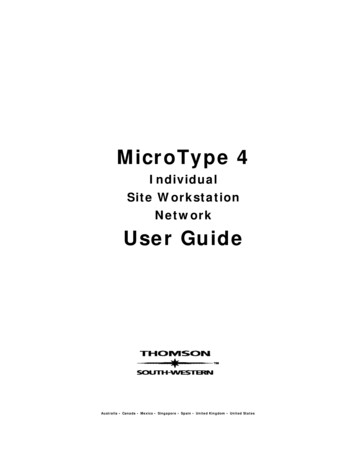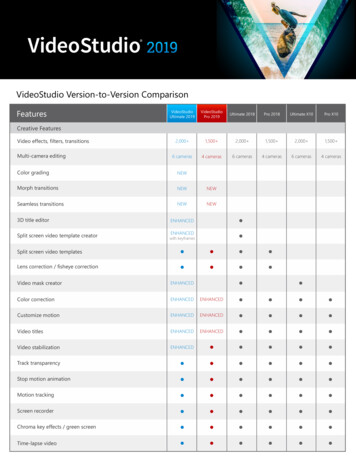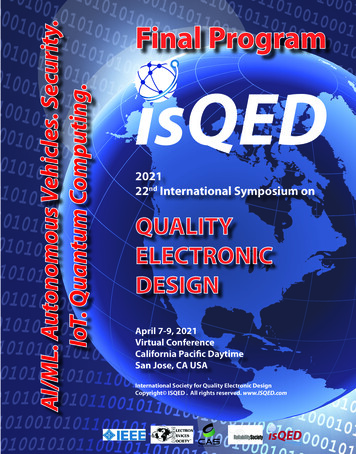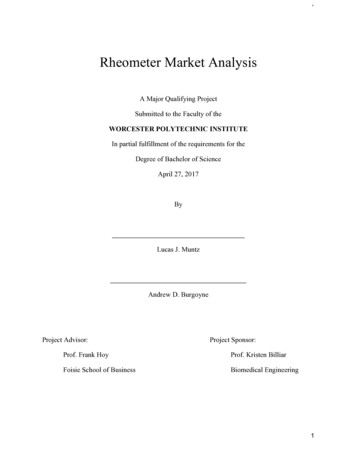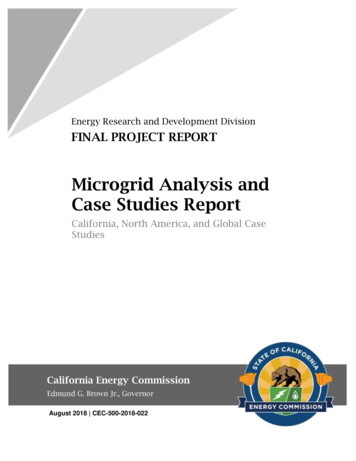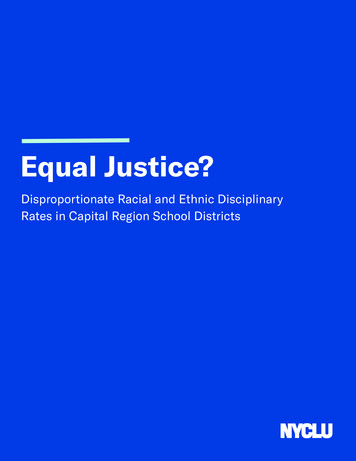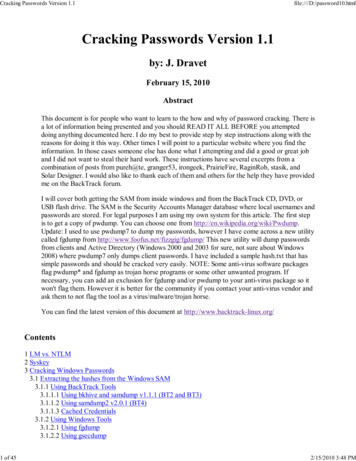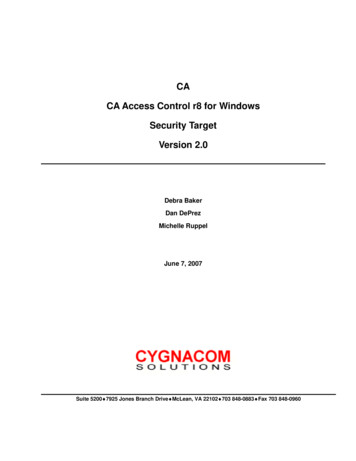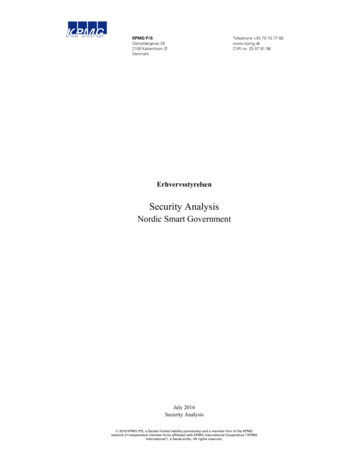
Transcription
ABCDKPMG P/SDampfærgevej 282100 København ØDenmarkTelephone 45 70 70 77 60www.kpmg.dkCVR no. 25 57 81 98ErhvervsstyrelsenSecurity AnalysisNordic Smart GovernmentJuly 2016Security Analysis 2016 KPMG P/S, a Danish limited liability partnership and a member firm of the KPMGnetwork of independent member firms affiliated with KPMG International Cooperative ("KPMGInternational"), a Swiss entity. All rights reserved.
ABCDErhvervsstyrelsenSecurity AnalysisJune 2016Contents1Executive summary31.11.21.31.41.5PurposeResults of the risk analysisSecurity designConclusionSuggested next step334452Background, Scope and 3High-level Security Model83.1The Smart Government visionHigh-level security principles884Risk Framework and Assessment114.1Risk analysis approachEstablish driversProfile assetsIdentify threatsIdentify and mitigate risks11111213145High-level Security LoggingEncryptionRecovery19191920206Conclusions & B.3B.4B.5B.6Qualitative MeasuresAssetsInformation ContainersThreatsRisk OverviewRisk matrix232426282930Security Analysis - final version v1.0 - 12 July 2016 2016 KPMG P/S. All rights reserved.1
ABCDErhvervsstyrelsenSecurity AnalysisJune B.8.9B.8.10MitigationsRisk worksheetsRisk 1Risk 2Risk 3Risk 4Risk 5Risk 6Risk 7Risk 8Risk 9Risk 10313333343536384042444648Security Analysis - final version v1.0 - 12 July 2016 2016 KPMG P/S. All rights reserved.2
ABCDErhvervsstyrelsenSecurity AnalysisJune 20161Executive summary1.1PurposeThe purpose of this report is to deliver a high-level security analysis for an initial subset of theproject Smart Government (SG).The project SG aims to utilise the potential benefits of digitisation through automated exchangeof data between authorities and businesses within each country in the Nordic region. SG willprovide a way for authorities and relevant stakeholders to "pull" relevant data from companies,who already deposited the relevant underlying data in a cloud-based software solution. Effectivelythis will eliminate the need for businesses to prepare and file information multiple times.The initial scope is limited to Small and Medium Enterprises (SME) providing data to a subset ofgovernmental entities, but business to business communication and businesses providing dataservices are taken into account as well. Companies in the SME segment are relatively moreburdened by reporting than larger businesses, and likely do not have the means to maintain a fullBusiness Intelligence (BI) system.1.2Results of the risk analysisBased on a high-level security model, a risk analysis has been performed, and a range of mitigativecontrols have been analysed. The result of this analysis have been integrated into an overallsecurity design for the SG system.The high-level security model sets forth the following requirements:-Data is ingested on a continuous basis-Ingested data must be retrievable at any point in time or for any period (to use as basisfor decisions or to prove correctness of decisions based on the data available at thetime)-Data should be tagged/classified on ingest (e.g. "Billing transaction")-Rules for data retention, according to classification, should be created when changingthe data plan (including how long raw data is needed and when aggregated data replacesraw data as sufficient legal grounds)-Access should be granted to authenticated named entities/users (no sharedaccess/anonymous)-Authentication mechanism should support/integrate with existing governmentalauthentication frameworks-Data access authorisation should be granted by the data owner (explicitly or implicitly)-Data access authorisation should be (support being) granted for a time limited period(with start and end dates)-Granted data access should be revocableSecurity Analysis - final version v1.0 - 12 July 2016 2016 KPMG P/S. All rights reserved.3
ABCDErhvervsstyrelsenSecurity AnalysisJune 2016-Data access should be traceable, showing who has accessed a given data asset at a giventime-Data should be stored and transmitted in a manner that prevents circumvention of theauthorisation mechanism.The recommendations set forth are to implement Governance, Risk and Controls (GRC), managedthrough an Information Security Management System (ISMS) such as ISO 27001. This will formthe basis for ensuring that the proposed mitigating controls are implemented and effective, as wellas continuously adjusted to changes in the threat landscape.1.3Security designBased on the risk assessment of the visionary design and the data model, the main focus of thesecurity design is on preventing unauthorised access to and alteration of data. This is done throughthe following mitigating techniques:-A policy defining responsibilities and ownership of data-A framework for authorisation that is built on top of a mechanism for authentication-A principle of granting minimal access based on need-Technical protection based on encryption of data at rest and during transport-Technical protection based on principles for secure code development-Technical protection based on segregation of test/development and production systemscombined with data obfuscation (stripping, anonymisation and pseudonymisation)-Reactive controls to identify if the access controls are being circumvented, such asLogging, Intrusion Detection and Prevention Systems, machine learning to locateirregular access patterns, etc.Further focus is put on availability of data, which is done through the following mitigatingtechniques:-Implementation of Change and Capacity Management processes-Implementation of backup and restore procedures-Implementation of general operational procedures and event management process.It should be noted that the availability aspect would potentially become more critical with abroader system scope where e.g. business critical transactions (ordering parts, invoicing, etc.) aresupported, as downtime could disrupt the supply chain of the individual businesses.1.4ConclusionIf these recommendations are adhered to, further developed and implemented effectively, wedeem that it is possible to create an SG environment in which data is handled in a manner thatprevents unauthorised access and data loss while still providing the envisioned benefits toenterprises and government institutions.Security Analysis - final version v1.0 - 12 July 2016 2016 KPMG P/S. All rights reserved.4
ABCDErhvervsstyrelsenSecurity AnalysisJune 2016This is, however, dependent on the future selected IT architecture, which should be risk assessedas part of the development process.1.5Suggested next stepOur recommended next step is to create a general requirement specification for the SG system, inwhich the functional as well as non-functional (e.g. security) requirements are fleshed out. Thisspecification could be shared among the Nordics, allowing relevant areas to be adjusted forspecific national requirements.Once the requirement specification has developed, next steps could likely be to implement aProof-of-Concept system in which the selected product and actual implementation can be testedand evaluated. The Nordic countries could choose either do this as a joint project, or as nationalprojects according to needs and preferences.Due to the modular and dynamic way data is stored, we expect it to be possible to expand the PoCsystem once it has reached a sufficient maturity level, rather than reimplement for a bigger scope.Security Analysis - final version v1.0 - 12 July 2016 2016 KPMG P/S. All rights reserved.5
ABCDErhvervsstyrelsenSecurity AnalysisJune 20162Background, Scope and Methodology2.1BackgroundIn April 2016, Erhvervsstyrelsen (ERST) requested KPMG to perform a high-level securityanalysis for the project Smart Government (SG). Concurrently, ERST requested Deloitte toperform a high-level data-model analysis.The project Smart Government (SG) aims to utilise the potential benefits of digitisation throughautomated exchange of data between authorities and businesses within each country in the Nordicregion. SG may provide a way for authorities and relevant stakeholders to "pull" relevant datafrom companies, who already deposited the relevant underlying data in a cloud-based softwaresolution. Effectively this will eliminate the need for businesses to prepare and file informationmultiple times.The business drivers described in the vision papers are:-To create a single point of financial reporting for a company, off-loading much of theadministrative work from the company and automating it.-To enable continuous reporting of data in order to-2.2-get increased insight into current status of businesses-create up-to-date statistical data on which to base (e.g. fiscal political) decisions-perform automated fraud detection/risk response through machine learning.To implement an open framework in order to-let any relevant vendor integrate into the framework-enable an extensible data model that allows stakeholder-specific changes to thedata plan, i.e. allow the possibility of extending the types of data that entitiescan upload and share based on future needs.-increase the service offerings relating to and business value of uploaded data-support increased digitisation and value to companies.ScopeThe scope defined for this initial security analysis is as follows:-Stakeholders are limited to Small and Medium Enterprises (SME) providing data to asubset of governmental entities consisting of the Tax Authorities, Business Authoritiesand Statistical Authorities.These companies are relatively more inconvenienced by reporting and likely do nothave the means to maintain their own BI systems.-Data is limited to financial data, billing data, accounting data, data from digitalcommunication with businesses and data from preliminaries (such as tax files frombusinesses).Security Analysis - final version v1.0 - 12 July 2016 2016 KPMG P/S. All rights reserved.6
ABCDErhvervsstyrelsenSecurity AnalysisJune 2016To ensure future expansion the model also considers the possible data exchange betweenbusinesses (B2B) as well as the possibility of businesses to act as data-service vendors (BI).2.3MethodologyThe methodology applied to perform the Security Analysis is based on the following steps:-Design security principlesBased on project documentation and interviews with the ERST team, high-level securityprinciples and associated stakeholders are identified.-Create risk modelRelevant threats, threat actors, vulnerabilities, events, etc. are scoped.Based on the identified principles and the performed scoping, a relevant risk frameworkis selected.-Perform risk assessmentThe risk model is applied to the scoped threats, etc., and possible mitigation techniquesare evaluated.-Design security modelOne or more security models are suggested based on the assessed risks and the proposedmitigation techniques.-Put model in Nordic perspectiveThe model is put under high-level assessment in relation to differing legislation acrossthe Nordics.-Provide recommendationsA set of security recommendations including implementation recommendations andbest practice are set forth.Security Analysis - final version v1.0 - 12 July 2016 2016 KPMG P/S. All rights reserved.7
ABCDErhvervsstyrelsenSecurity AnalysisJune 20163High-level Security ModelIn order to assess risks to the data assets, the Smart Government vision has been modelled intoabstract components that interact with data assets.3.1The Smart Government visionThe main "cloud" vision as described in the paper "Visionspapir om Smart Government – 120115"is shown below with the primary stakeholders (SME's, Tax Authorities, Business AdministrationAuthorities and Statistical Authorities) indicated.Although the primary focus has been on the entities that would be involved in a "basisimplementation" (simplifying the SME's reporting to government entities), the extended usagescenarios have not been ignored. The security model has been generalised to an extent where therisk assessments of data access by government entities also covers enterprise (B2B & BI)access.Based on the business drivers listed in section 2 and best practices, a set of high-level securityprinciples can be defined.High-level security principlesThe model should adhere to the following high-level security principles:-Data is ingested on a continuous basis.-Ingested data must be retrievable at any point in time or for any period (to use as basisfor decisions or to prove correctness of decisions based on the data available at thetime).-Data should be tagged/classified on ingest (e.g. "billing transaction").Security Analysis - final version v1.0 - 12 July 2016 2016 KPMG P/S. All rights reserved.8
ABCDErhvervsstyrelsenSecurity AnalysisJune 2016-Rules for data retention according to classification should be created when changing thedata plan (Including how long raw data is needed and when aggregated data replacesraw data as sufficient legal grounds).-Access should be granted to authenticated named entities/users (no shared/anonymousaccess).-Authentication mechanism should support/integrate with existing governmentalauthentication frameworks.-Data access authorisation should be granted by the data owner (explicitly or implicitly).-Data access authorisation should be (support being) granted for a time limited period(with start and end dates).-Granted data access should be revocable.-Data access should be traceable, showing who has accessed a given data asset at a giventime.-Data should be stored and transmitted in a manner that prevents circumvention of theauthorisation mechanism.The in-scope parts have been modelled in the following way:The data store contains the data at rest, while stakeholders upload or download data through amiddleware layer. The model allows for future scope expansion where businesses can downloaddata as well, since both the businesses and the authorities have been modelled in the same way.Security Analysis - final version v1.0 - 12 July 2016 2016 KPMG P/S. All rights reserved.9
ABCDErhvervsstyrelsenSecurity AnalysisJune 2016The business uploading data retains ownership of the raw data. Once data is aggregated anddownloaded, ownership of the resulting data transfers to the aggregating party.The security model can only handle data inside the SG system – once authorisation to downloadraw data has been given, and data has left the SG security environment, security has to bemaintained on the downloading system by the downloading stakeholder.Security Analysis - final version v1.0 - 12 July 2016 2016 KPMG P/S. All rights reserved.10
ABCDErhvervsstyrelsenSecurity AnalysisJune 20164Risk Framework and AssessmentTo assess the risk level of the envisioned system and design mitigating controls, a relevant riskframework needs to be selected.Due to the high-level nature of the current design, the risk framework should not be based on aquantitative approach. Rather, a qualitative approach should be used, in which an opinion- andscenario-based rating system is used to assess risk criticality levels.A selection of international frameworks has been considered (NIST 800-30, FRAP, OCTAVE,FMEA, CORAS). The risk framework that has been selected is OCTAVE Allegro, based onseveral factors:-It has a wide approach, contemplating the entire system and not just parts thereof.-It is not focussed on technology, which is an advantage when no actual technology hasbeen decided.-It is focussed on information assets.-It does not require extensive involvement from the data or system owners (at this levelof abstraction)-It includes risk mitigation considerations as part of the model.OCTAVE Allegro can be used in conjunction with ISO/IEC 27005, the ISO/IEC 27000standard for information security management systems (ISMS), as the ISO/IEC 27005 does notspecify a specific risk model to be used.4.1Risk analysis approachThe OCTAVE Allegro framework consists of an eight-step methodology, based on four distinctareas:-Establish drivers, where the organisation develops risk measurement criteria that areconsistent with organisational drivers.-Profile assets, where the assets that are the focus of the risk assessment are identifiedand profiled and the assets' containers are identified.-Identify threats, where threats to the assets – in the context of their containers – areidentified and documented through a structured process.-Identify and mitigate risks, where risks are identified and analysed based on threatinformation, and mitigation strategies are developed to address those risks.Establish driversStep 1.Establish Risk Measurement CriteriaSecurity Analysis - final version v1.0 - 12 July 2016 2016 KPMG P/S. All rights reserved.11
ABCDErhvervsstyrelsenSecurity AnalysisJune 2016In order to assess the individual risks, the criteria for measuring impact has to be defined.This is covered in three main areas:-Reputation and customer confidence, covering the impact relating to trustworthiness andpolitical support.-Financial, covering operating cost and the ability to invoice taxes, etc.-Fines and legal penalties, covering risk of conflicts with legislation.The identified areas are then prioritised based on expected impact to the SG system. Theprioritisation is used later in the model to assign an overall risk value to individual threatscenarios.Additional information of the specific implementation of this step is available in Appendix B.1.Profile assetsStep 2.Develop an Information Asset ProfileAs the vision is very high-level, the information assets have been defined by the scope:Aggregated and transactional level information from businesses to the authorities for Tax,Business Administration and Statistics, as well as B2B and BI usage.The data is not defined closely, but will contain Personal Identifiable Information (PII) andfinancial data.Additional information of the specific implementation of this step is available in Appendix B.2.Step 3.Identify Information Asset ContainersOnce the information assets have been identified, the information flow is analysed to assess wherethe data is stored or handled (i.e. the information asset containers). In the context of the model ofthe SG vision, this leads to the following asset containers (grouped by data state):Data at rest:-Data storage, internal (SG repository of raw data and reports)-Data storage, external (external stakeholder having downloaded data)-Backup media, internal and external (where copies of data is stored for recoverypurposes)Data in transit:-Internal network (network connecting SG components)-External network (where the data is transmitted from SG to stakeholders, e.g. theInternet)Data in use:-IT staff, internal (with privileged access to SG internals)Security Analysis - final version v1.0 - 12 July 2016 2016 KPMG P/S. All rights reserved.12
ABCDErhvervsstyrelsenSecurity AnalysisJune 2016-IT staff, external (with privileged access to downloaded data, and to software thatinteracts with SG)-BI staff (with access to perform analysis on data)Additional information of the specific implementation of this step is available in Appendix B.3.Identify threatsStep 4.Identify Areas of ConcernBased on the identified data assets and asset containers, the following areas of concern have beenidentified:-A data owner disappears (e.g. stakeholder bankrupts/closes down).-A stakeholder is unable to access data (that he should have access to).-A stakeholder uploads false data.-Data integrity is compromised.-Data confidentiality is compromised.-Data is used in a manner not in accordance with granted permission of use.-Data is not retained/deleted according to retention scheme.-Employee privileges too broad/high.-Data is unavailable or lost due to system failure.-Data storage overloaded.-System compromised.Each of these areas is to be analysed as individual threat scenarios.Step 5.Identify Threat Sce
The scope defined for this initial security analysis is as follows: - Stakeholders are limited to Small and Medium Enterprises (SME) providing data to a subset of governmental entitie
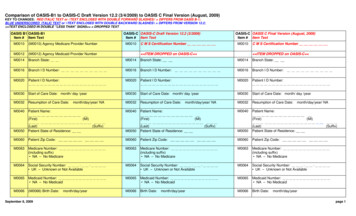
![Archive final version[1]](/img/5/2007.jpg)
